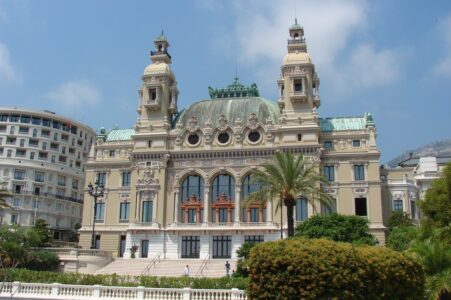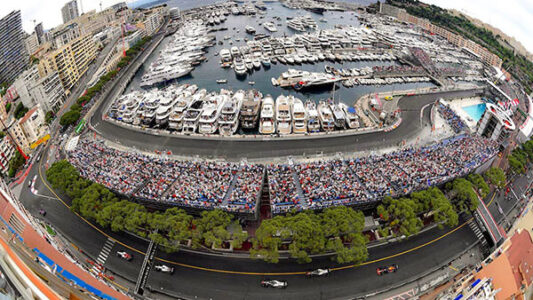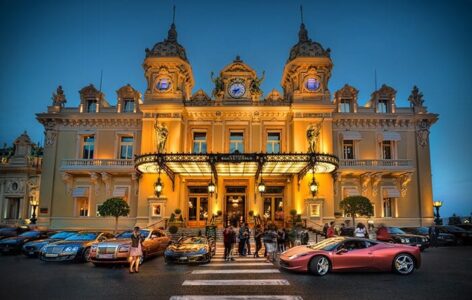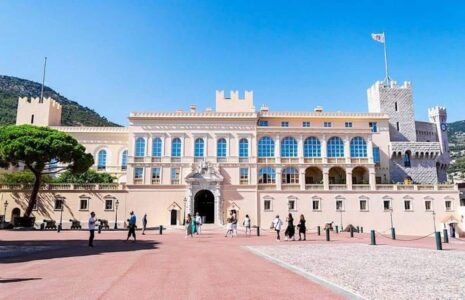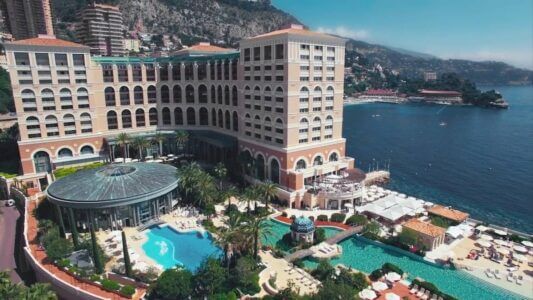Hemmels: Custodians of the Classics

The Welsh company specialises in rebuilding classic Mercedes models to modern standards, including electrification.
A very select event took place in Monaco, and more specifically the wine cellars of the Hotel Hermitage, on Saturday evening, April 20. The Cardiff-based car company Hemmels invited a number of guests to enjoy a VIP dinner, and the opportunity to admire four classic, ‘reborn’ Mercedes models, including their very first electric vehicle.
Monaco Tribune was there and was granted an interview with Hemmels’ Chairman and Primary Owner, Richard Butterfield.

Modern-day stewards
Who doesn’t love a classic Mercedes? The sleek lines, the reliable engineering, the quality finish… Hemmels believes that these automotive beauties have a past, a present and, thanks to their expert and talented workforce, a beautiful future. “Our mission is to preserve classic cars and the iconic stories they tell. We chronicle the history of our Mercedes-Benz models and carve our own place in the narrative as their modern-day stewards. So that way you can continue the story for another generation,” reads Hemmels website.
A labour of love that requires 4000 hours
Craftsmanship
The company works on a wide range of models, exclusively Mercedes. Its ethos is all about quality, not quantity. Only a select number of cars, between 12 and 20, are restored every year, inside and out. Stripped back to the bones, every detail in the car is rebuilt, restored, recalibrated using ‘pioneering, reliable and sustainable technology’ and re-upholstered by hand to the future owner’s specifications for the ultimate bespoke experience. A labour of love that requires 4000 hours… roughly a year per car.

Why Mercedes? Why Monaco?
Richard Butterfield explains: “Seven years ago, I decided I wanted to buy a Mercedes. I went all over the world trying to find somebody who would create exactly what I want. Perfect detail. Change some details, make it perfect. I found a company in Wales after I’d been to the United States, Germany… And the company was for sale.” Since taking over, Butterfield has steered investment in the company towards electrification. “And we know Monaco, are real leaders in terms of the green energy.”
He recognises the Prince’s role in this, as well as the Sovereign’s love of cars, “he loves the idea of beautiful cars, original cars that are turned into 21st century electrification.” And, in places like Monaco, “people love having a beautiful old car, and everybody looks at the car and thinks it’s original. But really, they want to fly the flag to show that they’re doing something” for the environment.
Our cars will carry an antenna which will pick up signal from beacons around the city, charging as you drive
As we walk round the Pagoda Electric, premiered at the event, Butterfield explains that its electric platform was designed for use in their other models, giving customers the choice between the original petrol car or an electric one. Another link to Monaco is through ground-breaking technology, developed for Hemmels by a company in Dubai, the first company in the world to develop wireless charging.
The Welsh company’s Chairman and primary owner tells us that within the next two years maximum, their cars will carry an antenna which will pick up signal from beacons around the city, charging as you drive. Ideal for a country with a small footprint, like Monaco. And while the technology will start out in this incredibly select model, it will ultimately move into mainstream cars.

Once these metal birds fly the Hemmels nest, the question of maintenance arises of course. Having sourced past models, and modernised them, Hemmels are also keen that their reborn cars age well. “We’ve even gone to the trouble of certifying our technology so that we can sell a small number of these cars around the world, and they can be looked after by Mercedes dealers because they are mainstream electrical components.”
However, the global certification process cost millions of pounds. “We can send a safety certificate, we can provide a warranty, everything that goes with it. We don’t make money out of building those cars, but we will make money by selling the technology we’ve developed to other manufacturers. Also, the technology companies are using ours as their development test. There is no better profile for new technology than putting it into a beautiful car that everybody sees,” says Butterfield.
“The better the history on the car, the more the value”
We asked what the main challenges are when restoring these classic cars. The short answer is ‘getting the parts’. The cars are 1950s and 1960s models, and the components no longer exist. “First of all, the car has to be original,” says Butterfield. “We literally take the car to zero. And we start again. But we improve all the parts that go into the car, and where we can’t buy the parts or Mercedes no longer makes them available, we make them, better than the original.”

Also difficult is finding the ones that have survived, because 20 years ago, these were “just an old car.” Hemmels sends people all over the world to source them. “We can produce our cars for the next 10 years,” without worrying about supply for the 190s and 230s, which survived in the dry climates of the US. Others are much rarer and are constantly growing in value.
The condition isn’t important, since the car will be ‘reborn’ from scratch, it’s the story behind it that matters. Its previous owners, for example. “The better the history on the car, the more the value.” “We bought a car in Argentina; it had been owned by Fangio.” Another link to Monaco, where the racing driver won several races. And the Argentinian’s car was a gift when he won the World Championship for… Mercedes of course.
No such thing as a typical Hemmels customer
At present most of Hemmels’ customers are in the United States. And it’s the customers who find the Cardiff company, not the other way round. “They hear the story like I did originally seven years ago,” says the company Chairman. Because Hemmels rebuild the car from scratch, it looks perfectly original, but customers can ask for power windows, a powered roof, a modern alarm system… all the ‘mod cons’. “On the 300, for example, it was never available with air conditioning, so we’ll build air conditioning. But we do it so people can’t see.”
I want that car because it’s just really cool
“We have two types of customers these days,” says Butterfield. “Some say, I don’t want it looking original at all. I want it totally tailor-made. Others say, I want it to look like the day it was new. That was that colour, the leather was this colour. But it’s better leather, it’s better paint.”
The audience is changing, however. When Butterfield started collecting cars, the typical buyer was in his sixties and bought the cars as collector’s items, remembering them from days gone by. A nostalgia trip if you will. “Now, we find a lot of people who say, “I want that car because it’s just really cool.” Women absolutely love the 280 SL, but they don’t want something where it doesn’t start, or the brakes don’t work.”
The appeal of authenticity, of the unique
So, what is the appeal? As Butterfield puts it, “Anyone can buy a modern car. You’ll see a Ferrari on every corner in Monaco. And Ferrari will paint it a different colour for you. But lots of other people have got a Ferrari. ‘Cool’ is now about being seen in something that nobody else is.
As for older cars, but making them drive like a Ferrari, not many people have them! People call us and say, “We’ve seen your car. Can we buy that car?” And we say, “Well, no, we’re building it for a particular customer.”
Obviously, unique and bespoke comes at a price. Hemmels’ pricing structure is a menu of services based on the heritage of the donor car. One of the models on display at the Hotel Hermitage was sourced in the United States. “It had only done 20,000 miles. All the numbers match perfectly through the car, and that adds value.”

Hemmels will find a car that fits what the customer wants to do with the car, and then build a price depending on where they want to go with it. A blue model that was on show on Saturday was all Rolls-Royce paint. “The car goes faster; it has better brakes. Yet it looks very original. And a finished car like that costs over $400,000.”
Given that Hemmels’ raison d’être is rebuilding unique cars to spec for a discerning clientele, the company receives some equally unique requests. Butterfield insists “I don’t allow myself to be the taste police for other people, but our advice is, if you want to grow the value of the car, don’t go too crazy.”
He told us one of the cars featured at the weekend event “will be worth a million pounds more in five years’ time than it is today because these are so rare. Mercedes in the 1950s produced a very small number of this top-of-the-range 300SL. They were the world’s first genuine supercar, along with the iconic flagship Gullwing, and they were bought generally by people like Cary Grant or Sophia Loren. A car like this, based on rarity and on originality, but turned into perfection, will grow in value.”
Celebrity owners
As well as Grant, Loren, and Fangio, several of the cars Hemmels have loving restored have belonged to celebrities along the way. A white 1975 model that was for sale at Saturday’s event was owned Olympic Studios in the UK, where Shirley Bassey recorded. Dame Shirley was present at the Hotel Hermitage event, and reminisced fondly about the studio, where the car was ever-present. “I love the romance and the story of the cars as much as the cars themselves,” says Butterfield.

Details, details…
For the company Chairman, as a collector himself, it’s all about the details. A partner company was found to take the original Mercedes instruments, then redesign and redevelop them to work in an electric car. Normal cars have a speedometer, a rev counter, an indicator for oil pressure and temperature. For the electric version, they had to repurpose all these dials as a power metre, yet it’s an original instrument.
If somebody says, I’d like to have power windows, we leave the handle and we turn it into a switch
The petrol has a beautiful chrome gear selector gate. On an electric car, there is only forwards, reverse, and park. So, linkages were reengineered to work there. “On the Mercedes, the sun visors were made of plastic. And they’re horrible. So, we take beautiful leather, and we stitch beautiful leather for something as simple as the sun visor. If somebody says, I’d like to have power windows, we leave the handle and we turn it into a switch. So that when somebody looks inside the car, they think, “Oh, it has the beautiful wind-up windows.”
As the interview concluded, Richard Butterfield said, “Monaco is a totally new audience for us. We’d love to be able to work with people in Monaco who want a bespoke journey for their car. We think there are people in Monaco who, like me, appreciate perfect detailing.”
While enhanced versions of their petroleum engine cars are available to drive right now, when can we expect to see the first electric Hemmel on the road? “The only thing that’s stopping this car driving around Monaco today is the insurance certification. The last of the safety testing. Going through the legal process and getting through the legislation, particularly in the United States, to be able to sell that car to somebody and for them to buy it as though they’re buying a Tesla… that’s been a monumental journey.” A journey that should end in around 3 months’ time. Which of course will be the start of a new journey for these restored cars. Or rather, reborn classics.

